
Start: Winchester Cathedral. End: Alresford. Distance: 9 miles. Difficulty: Easy
We started our ‘pilgrimage’ arriving at Winchester Cathedral on Good Friday 2023 – still not all 6 of us although the Eldest, finally discharged from hospital was with us, GD remained at home revising for A levels, having ruptured her ACL and waiting for surgery. Nothing is simple. Perhaps this was why I hadn’t quite thought through the logistics; a place of worship on one of the most important days in the Christian calendar might be just a little busy. Despite this I happily rocked up to the Welcome Desk in Winchester Cathedral asking for 5 Pilgrims’ Passports and requesting to be taken to the shrine of St Swithun’s in the Cathedral, from where you’re supposed to have a formal ‘sending off’. The staff were incredibly kind and Ian, one of the vergers, terribly accommodating; he explained that they were getting ready for a 3 hour Good Friday service after a busy week. He still took time to guide us around the Cathedral and to St Swithun’s shrine. St Swithun became the city’s Bishop in 852 and was known for his charitable gifts and restoring and rebuilding Hampshire’s ancient churches. He also built a stone bridge over the River Itchen helping the poor cross the river to sell their wares in the city. He died in 862 and was buried outside what is now the Cathedral, as he requested, where people could walk over his grave and rain fall on it. This became a shrine known for its healing powers. 100 years later on 15 July his remains were moved into an elaborate shrine inside the Cathedral. A violent storm followed and legend has it that whatever the weather is on 15 July, it will remain for the next 40 days. St Swithun is the patron saint of droughts as well as Winchester’s own saint. Over the years his body parts were taken to various different places – in 1006 the Bishop of Winchester St Alphege took Swithun’s head (yes, really) to Canterbury Cathedral (it was then moved to Evreux Cathedral in Normandy), an arm to Peterborough’s Abbey (now Cathedral) and in 1128 a monk took an arm to Norway where Stavanger Cathedral is dedicated to St Swithun. During Henry VIII’s destruction during the Reformation, the remaining bones of St Swithun were lost when his shrine was destroyed by Thomas Cromwell.
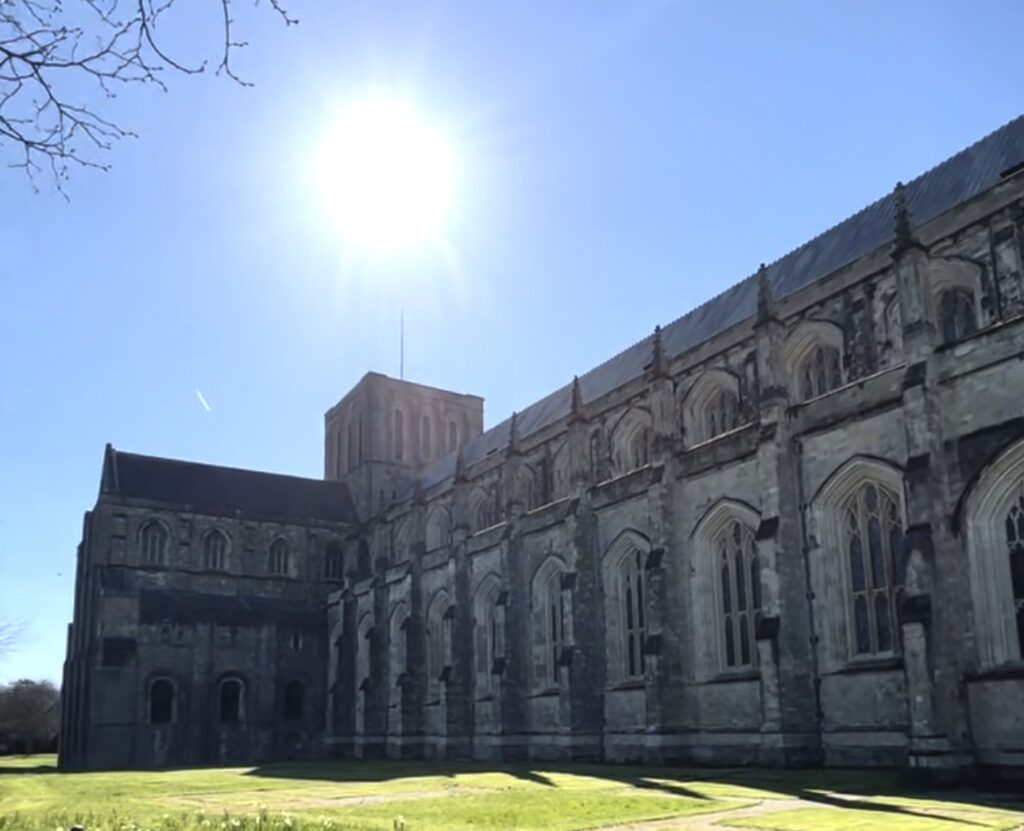
As we walked around the Cathedral, our footsteps echoing in the, for now, empty and hushed space, we thought about all the pilgrims who must have gone before us over the last thousand years plus. It’s quite extraordinary – the world has changed beyond recognition yet we are standing where kings, knights and saints once stood. The floor, known as the tile pavement, dating from the 13th Century, is in the Retrochoir and is the largest area of medieval tiles in the UK and one of the most significant collections in Europe; I’m staggered that there is still public access and I wonder how long this will continue given the continual wear and tear of the footfall of visitors. Although we didn’t received a formal Pilgrim Blessing as the clergy were all rather busy getting ready for the service, being shown around the empty Cathedral was a real privilege and the perfect start to our Pilgrims’ Way walk.
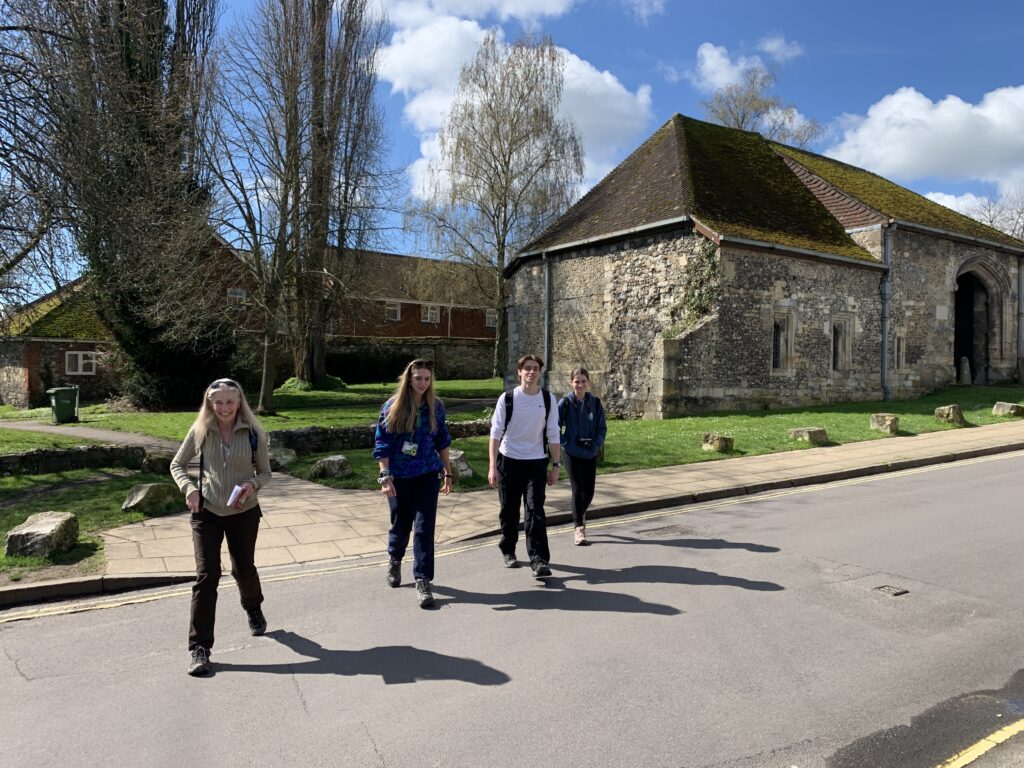
After the calm and quiet of the Cathedral, we walked through the tree lined avenue and past the tiny Church of St Lawrence reaching the bustle and busyness of the city. Eventually on the edge of the city we find the remains of Hyde Abbey. Hyde Abbey is believed to be the burial place of Alfred the Great although the only substantial part of it now is the 15th Century abbey gatehouse. I was astonished at coming across this place just steps from the city and surrounded by more recently built residential homes – I’d never even heard of it before. It probably has huge national historic significance – there’s been excavation work done in local gardens over the last few years and more is being discovered every year. If you’re interested this link has far more information including various events http://www.hyde900.org.uk. Further along the walk we discover that we should have popped into St Bartholomew’s Church, the only active remnant of Hyde Abbey, to get a stamp for our Pilgrims Passport although I think that you have to give a week’s notice; I’ve subsequently discovered that you can also get a stamp from The King Alfred pub that we walked straight past – definitely easier!
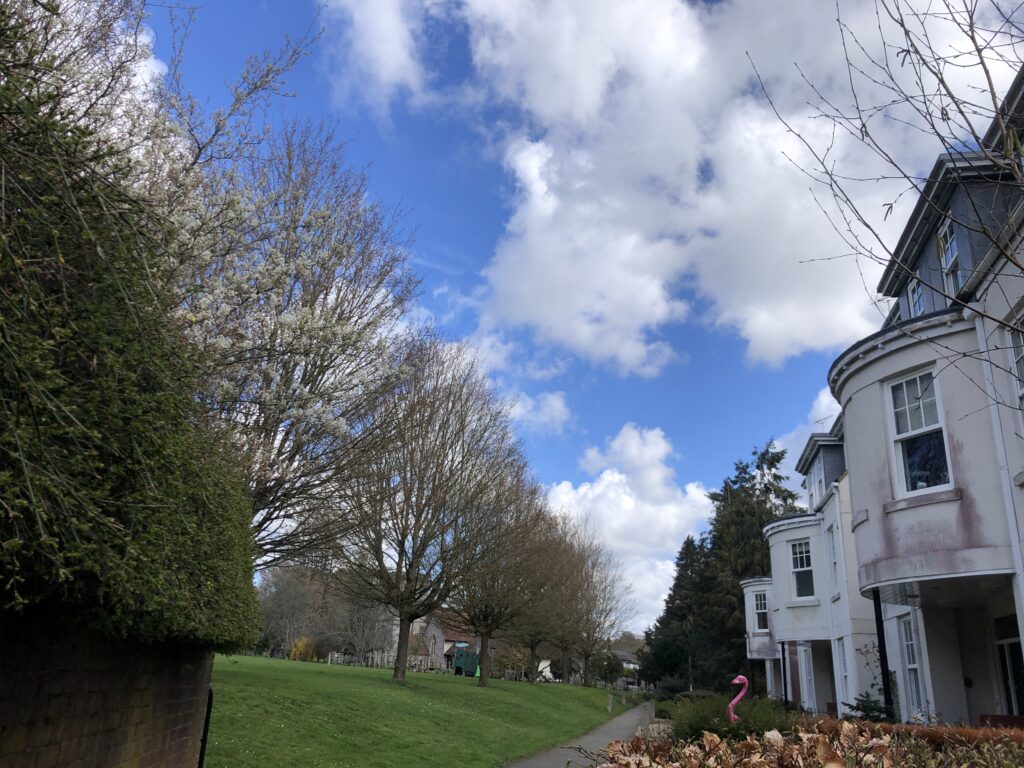
We walk next to a stream with allotments running alongside on the opposite bank and then the path has views across water meadows as it takes us towards Kings Worthy. The Pilgrims’ Way routes through a small industrial estate before opening onto a green overlooked by bow fronted houses. We reach St Mary’s Church that partly dates back to Norman times but most of what is now seen is Victorian restorations. In this little church the names of the rectors are recorded dating back to 1290. Memorials include a gold plaque to 19 year old AV Barker, once a chorister in the church who was onboard the Titanic when it sank; his body was never recovered. St Swithun is shown in a tiny 1490 window. A memorial outside remembers Lord Eversley, one of the founders and earliest members of The Open Spaces Society 1865, the UK’s oldest national conservation body. He opened up Hampton Court Park, Kew Gardens and Regent’s Park to the public. Such an important organisation, now more than ever. And we managed to get our passports stamped!

From Kings Worthy, the path takes us to the lovely Grade I listed St Swithun’s Church in Martyr Worthy dating back to 1043. In his book, England’s Thousand Best Churches, Simon Jenkins describes a rood (cross/crucifix) carved from Quarr stone, above the original entrance of the church ‘one of the most important carved fragments of the pre-Comquest period’ showing the crucified Christ with the Virgin Mary and St John on either side and the hand of God reaching down from the heavens; according to Jenkins ‘… a treasure of international status’.

The church was dedicated to St Swithun’s and is listed in the Domesday Book in 1086. This is a real gem of a church and we spent time looking around it and reading the gravestones which always give such an insight into past, sometimes tragic, lives. Plus there was another stamp for our Pilgrim’s Passports!
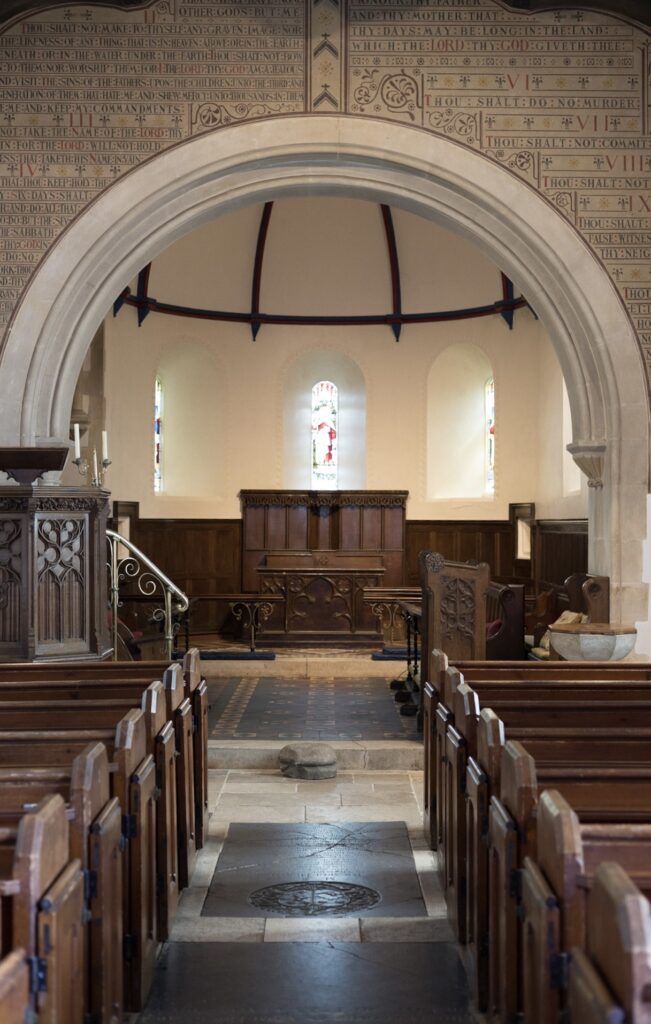

From the tiny village of Martyr Worthy we walked above the River Itchen before arriving in Itchen Abbas and its church, St John’s. It’s been a centre of worship since Norman times, possibly earlier although the current church building dates from 1862, when it retained the original Norman porch and chancel arch. We confidently strode towards the closed door but on hearing singing from within – it was Good Friday remember – we decided to pop into the local Plough Inn which also had one of the Pilgrims’ Way stamps. Before leaving the churchyard we found the tombstone of 26 year old John Hughes who was the last person in England to be hanged for stealing horses in 1825; a pretty barbaric penalty I think. The local rector, Robert Wright, paid for his burial in the churchyard – he obviously felt the same way. At that time horses were extremely valuable and their theft could even result in transportation to Australia. John Hughes was part of a Gypsy community and was dealt the most severe punishment. The rector had even travelled to London to plead for Hughes’ life, but to no avail. Reverend Wright ensured that Hughes was buried near his daughter who had died a few years earlier. All very tragic and shows a fascinating part of our history. One of the yew trees in the churchyard is believed to be over a thousand years old.
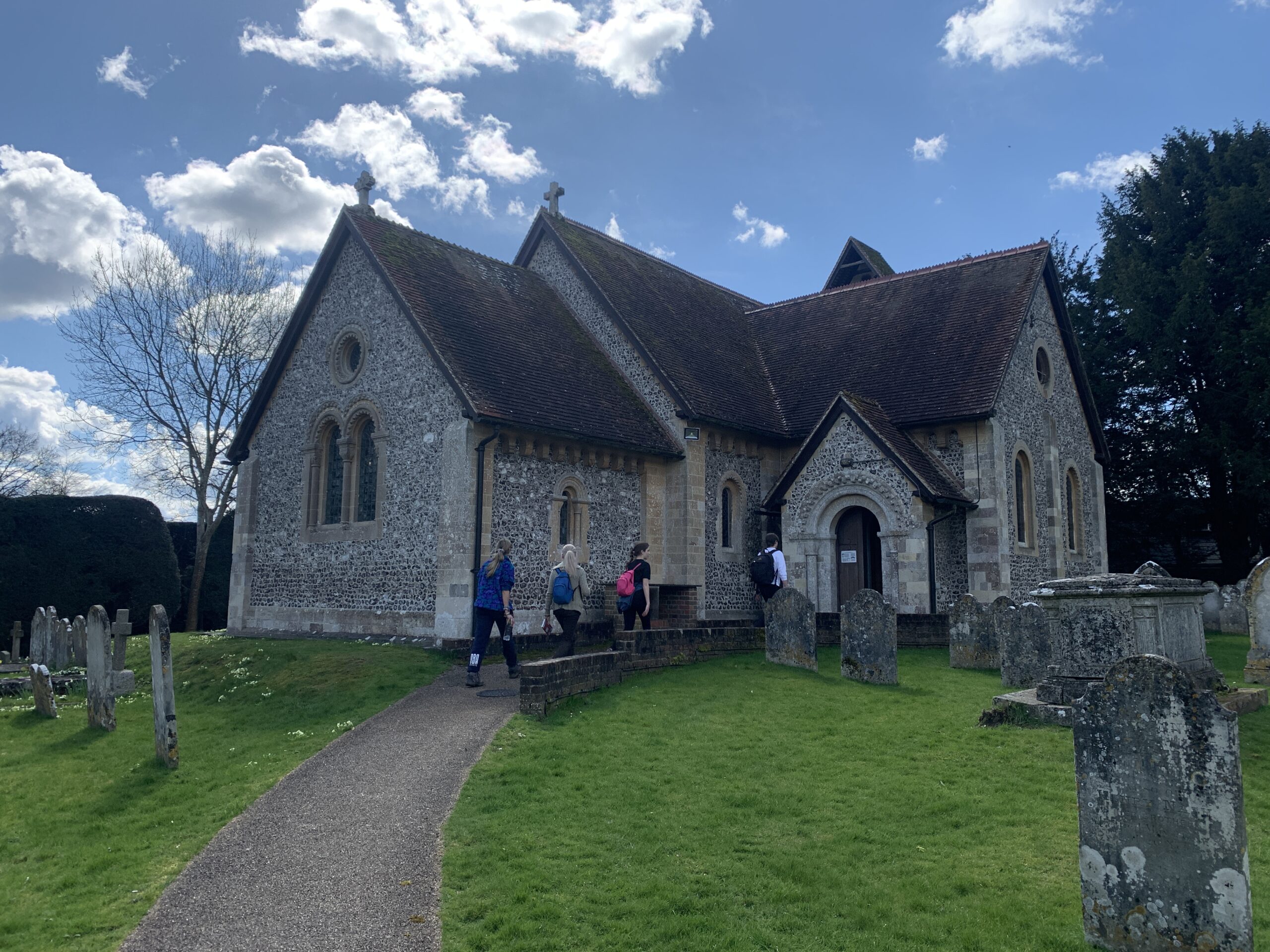
The Plough was busy and the staff happy to stamp our ‘passports’ and it was a good excuse for a drink in the garden looking down onto a tributary of the River Itchen. This is supposedly where Charles Kingsley found inspiration for his fateful novel The Water Babies. Sir Edward Grey, Foreign Secretary in 1914 apparently fished here the day before he saw the ‘lights go out all over Europe’ as WWI was declared. The bucolic calm of the river couldn’t have been further from what was to ensue.

Thirsts quenched we left the village over a pretty mill stream and past Avington Park that we’d seen in the distance from the opposite bank. The property dates back to 961 when it was a priory for the Monks of St Swithun. Later it was the home of Charles II and his mistress Nell Gwynn when it became known as a ‘party palace’! Lady Eleanor Shelley Rolls (the heiress of the Rolls Royce fortune) lived here until 1951 when the estate was broken up. Audrey Hicksen bought it ridiculously cheaply, writing to her husband in Burma “I have just bought a house. It doesn’t have 5 bedrooms, but 50. I think you should probably come home.” Their daughter more recently sold to the hotelier Nicholas Roach in 2020 and the doors have now been opened to visitors following a £8m restoration project. Leaving the historic house behind us the path takes us through the local golf club before returning to a more pastoral setting.

After Yavington Farm there is a stunning view across the Itchen Valley down to the River Itchen and across to the village of Itchen Stoke, its tall church rising above the other buildings. Walking down the road into Ovington we find the last church on this leg of the Pilgrims’ Way. St Peter’s is a 150 year old church of Victorian construction although a church has been on the site since the 13th Century. The original doorway was left rather bizarrely standing amidst the gravestones in the churchyard.

From Ovington it’s not long before we reach New Alresford and the watercress beds that it’s known for – it grows wild in the chalk streams and has probably been picked and eaten by local people for centuries. When the railway came to Alresford in 1865 it became a commercial proposition to transport the crop to London – picked in the afternoon, transported by cart to Alresford station in the evening and on sale in Covent Garden early the following day. There is now the Watercress Line, a steam train service that I’ve mentioned before.

And that’s it – the end of the first section of the Pilgrims’ Way – definitely easier in comparison to some of the 16-18 mile sections we did along the Wayfarers Way! The Cicerone book Walking The Pilgrims’ Way is brilliant and I would definitely recommend using it if you’re going to embark on this walk. Popping into the churches and occasional pub to get our Pilgrim’s Passport stamps definitely gave the walk a different feel and the various churches always had fascinating and quirky histories. Looking forward to the next leg!




